The Crane Trucks Market is estimated to be valued at USD 4.3 billion in 2025 and is projected to reach USD 8.1 billion by 2035, registering a compound annual growth rate (CAGR) of 6.5% over the forecast period. Early expansion is moderate, driven by the adoption of flexible lifting solutions in construction, logistics, and infrastructure projects. Initial growth is reinforced by rising urban development, industrial activity, and fleet modernization in key regions. Mid-period growth accelerates as technological enhancements, including higher lifting capacities, improved fuel efficiency, and advanced safety systems, increase market acceptance.
Expansion is further supported by rental services and aftermarket support, allowing wider access for small and medium enterprises. Later years demonstrate sustained momentum, driven by replacement cycles, retrofitting projects, and increasing integration of crane trucks in specialized sectors such as energy, ports, and heavy manufacturing. Year-on-year growth exhibits a consistent upward slope, reflecting gradual market maturation and broader adoption across industrial and commercial applications.
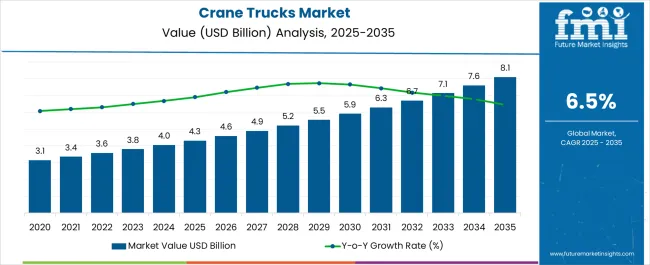
| Metric | Value |
|---|---|
| Crane Trucks Market Estimated Value in (2025 E) | USD 4.3 billion |
| Crane Trucks Market Forecast Value in (2035 F) | USD 8.1 billion |
| Forecast CAGR (2025 to 2035) | 6.5% |
The crane trucks market is experiencing robust expansion driven by accelerated infrastructure development, increasing urbanization, and the demand for mobile heavy lifting solutions across industrial and municipal projects. The versatility of crane trucks in accessing constrained job sites and offering immediate deployment without the need for extensive setup has made them a preferred choice for short term and on demand lifting operations.
Advancements in hydraulic systems, telematics integration, and safety automation have significantly enhanced operational efficiency and load handling precision. Additionally, fleet operators are emphasizing modularity and cost effective equipment maintenance, further reinforcing the market growth trajectory.
As governments invest in road networks, commercial buildings, and utility upgrades, the demand for adaptable lifting solutions is set to rise steadily, positioning crane trucks as a critical asset in construction and logistics ecosystems.
The crane trucks market is segmented by offering, lifting capacity, application, and geographic regions. By offering, the crane trucks market is divided into Lattice boom crane trucks, Telescopic crane trucks, and Knuckle boom crane trucks. In terms of lifting capacity of the crane trucks market is classified into Up to 20 tons, 21 to 50 tons, 51 to 100 tons, and Above 100 tons. Based on application, the crane trucks market is segmented into Construction, Utility, Mining, and Others. Regionally, the crane trucks industry is classified into North America, Latin America, Western Europe, Eastern Europe, Balkan & Baltic Countries, Russia & Belarus, Central Asia, East Asia, South Asia & Pacific, and the Middle East & Africa.

The lattice boom crane truck segment is expected to account for 47.60% of total revenue by 2025 within the offering category, making it the leading segment. This dominance is attributed to the structure's ability to handle heavy loads with greater stability and reach.
The modular assembly and transport efficiency of lattice boom configurations allow them to be deployed in large-scale projects that demand precision and strength. Their reduced operational footprint and flexibility across varied terrains make them ideal for infrastructure, energy, and mining sectors.
As project specifications grow in complexity and demand higher capacity with structural efficiency, the adoption of lattice boom crane trucks continues to rise, securing their position as the most relied upon offering in the market.

The up to 20 tons segment is projected to contribute 38.90% of the total revenue within the lifting capacity category by 2025. This is due to the growing need for compact and mobile lifting solutions that can operate efficiently in urban construction sites and light industrial operations.
The lower capacity range enables better maneuverability, lower fuel consumption, and reduced operational costs, which appeal to fleet managers and contractors alike. Furthermore, these units are suitable for routine utility work, residential development, and logistics support functions.
Their widespread use in both emerging and developed regions reinforces their significance in addressing mid-scale lifting tasks where versatility and cost effectiveness are prioritized.
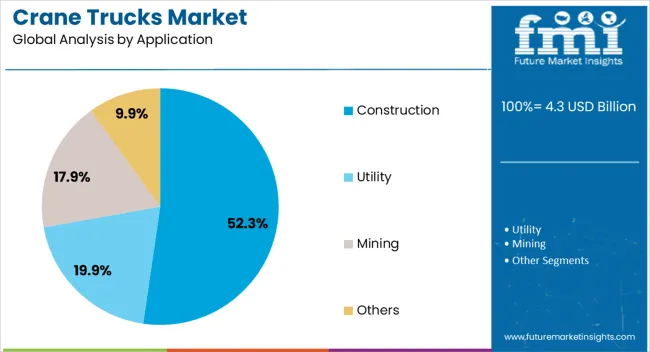
The construction segment is expected to lead the market by contributing 52.30% of the total revenue by 2025 under the application category. This leadership is supported by the surge in civil infrastructure projects, real estate development, and government investment in public works.
Crane trucks play an essential role in structural assembly, prefabricated material placement, and high-elevation load handling on construction sites. Their ease of deployment, adaptability across project stages, and ability to reduce manual labor make them indispensable in accelerating timelines and ensuring safety.
As construction firms continue to pursue mechanized lifting and modular building strategies, the demand for crane trucks in this sector remains strong, solidifying its position as the primary driver of market growth.
The crane trucks market is growing due to rising construction and infrastructure projects globally. Challenges such as high costs and regulatory hurdles persist, but opportunities in automation and logistics are driving innovation and market expansion.
The crane trucks market is driven by the expansion of construction and infrastructure projects globally. Increased demand for heavy lifting equipment in industries like construction, mining, and energy fuels growth. Crane trucks provide flexibility, enabling efficient loading, unloading, and transportation of heavy machinery, reducing downtime and improving project efficiency. Urban development and the construction of large-scale infrastructure, including bridges, highways, and residential complexes, contribute to the rising need for these specialized trucks. Governments' focus on improving road networks and logistics infrastructure further increases the demand for crane trucks, as they are essential in handling and transporting large-scale materials in complex construction environments.
Despite the growing demand, the crane trucks market faces challenges related to high initial costs, maintenance expenses, and regulatory compliance. The complexity of the machines requires specialized operators, which adds to labor costs. Crane trucks are expensive to maintain, requiring regular inspections, repairs, and safety checks. Stringent emission regulations and safety standards in various regions also impose additional compliance costs. These challenges may limit the adoption of crane trucks, especially in developing economies, where cost sensitivity plays a significant role in purchasing decisions. Ensuring safety and regulatory compliance remains a key hurdle for manufacturers and users alike..
The crane trucks market offers significant opportunities for growth in regions experiencing rapid infrastructure development. As countries continue to invest in large-scale construction projects, particularly in the commercial and industrial sectors, the demand for crane trucks will rise. Furthermore, the growing trend of automation in material handling presents an opportunity for manufacturers to develop more advanced and efficient crane truck models. Partnerships between crane truck manufacturers and construction firms can lead to more tailored solutions for specific industry needs, such as off-road or all-terrain capabilities. The increased adoption of cranes in logistics and distribution centers provides an expanding market segment for these versatile vehicles.
The crane trucks market is expected to see continued growth driven by increasing demand for lifting solutions across industries. The market will benefit from the rising trend of logistics companies requiring specialized equipment for transporting large loads. Moreover, government spending on infrastructure will support market expansion, with crane trucks playing a vital role in projects such as road construction, power plants, and industrial complexes. Manufacturers are focusing on improving crane truck designs, enhancing their lifting capabilities, and offering cost-effective models to cater to evolving market needs. With increased investments in large-scale industrial projects, the crane truck market will likely see robust growth.

| Countries | CAGR |
|---|---|
| China | 8.8% |
| India | 8.1% |
| Germany | 7.5% |
| France | 6.8% |
| UK | 6.2% |
| USA | 5.5% |
| Brazil | 4.9% |
The crane trucks market is expected to grow globally at a CAGR of 6.5% from 2025 to 2035, driven by increasing construction projects, infrastructure development, and rising demand for versatile lifting solutions. China leads with a CAGR of 8.8%, supported by rapid industrialization, large-scale infrastructure projects, and the growing need for advanced construction equipment. India follows closely with a CAGR of 8.1%, fueled by ongoing urban development, a booming construction sector, and increasing investments in logistics and infrastructure. France records a 6.8% growth, leveraging its position as a key player in European construction, while the United Kingdom posts 6.2%, driven by rising demand for crane trucks in infrastructure and urban development. The USA shows a more moderate growth of 5.5%, supported by the growing use of crane trucks in large-scale projects and construction across industrial and commercial sectors. The analysis covers over 40 global markets, highlighting these countries as key players in crane truck demand, equipment innovation, and market expansion in construction and heavy lifting industries.
China is projected to post a CAGR of 8.8% during 2025–2035, outpacing the global average of 6.5%. Key factors driving this growth include rapid industrialization, large-scale infrastructure projects, and substantial government investments in energy, construction, and logistics. The country’s need for versatile lifting equipment, including crane trucks, has intensified as the construction and mining industries continue to expand. Furthermore, with government support for major projects such as high-speed railways and urban development, demand for crane trucks in the region is expected to rise sharply. Technological advancements in crane truck designs, such as enhanced lifting capacities and energy-efficient models, also contribute to this robust growth.
India is expected to record a CAGR of 8.1% for 2025–2035, slightly above the global 6.5% rate. This growth is driven by the increasing focus on infrastructure development, urban construction, and the expanding logistics sector. From 2020 to 2024, the market grew at 7.2%, spurred by strong demand from the construction and mining industries. Key initiatives such as smart city projects, renewable energy developments, and industrial expansions in urban areas are expected to drive further demand for crane trucks. Furthermore, localized manufacturing and favorable government policies are improving the affordability and availability of these trucks. India’s crane truck market will continue to grow as new industries emerge and infrastructure development accelerates.
The UK crane truck market is projected to grow at a CAGR of 6.2% during 2025–2035, slightly lower than the global average of 6.5%. From 2020 to 2024, the UK market experienced a growth rate of 5.0%, primarily driven by a recovery in the construction sector, urban development, and demand for lifting solutions in industrial and infrastructure projects. The growth rate for 2025–2035 is expected to rise due to a significant increase in the construction of commercial buildings, transportation networks, and energy infrastructure. The need for highly specialized crane trucks in these projects, along with government-backed initiatives, is expected to support the market’s expansion. The focus on innovation and energy-efficient solutions will enhance demand in the long term.
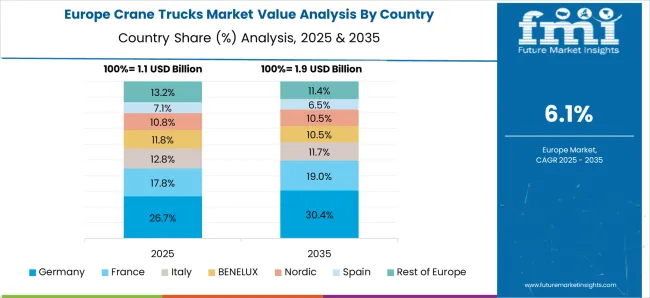
France is projected to achieve a CAGR of 6.8% during 2025–2035, above the global average of 6.5%. From 2020 to 2024, the market grew at a rate of 5.8%, driven by strong demand from the construction, energy, and industrial sectors. As the country continues to invest in infrastructure projects, such as high-speed railways, renewable energy facilities, and urban development, the need for crane trucks is expected to rise significantly. France’s strategic location in Europe also makes it a key hub for logistics and transportation, further increasing the demand for versatile lifting equipment. The rise in green energy projects, including wind and solar installations, also contributes to the growing demand for crane trucks, as these projects require efficient heavy lifting capabilities. As the French market continues to modernize its infrastructure, crane trucks will play an increasingly vital role in meeting the demands of large-scale construction and industrial projects.
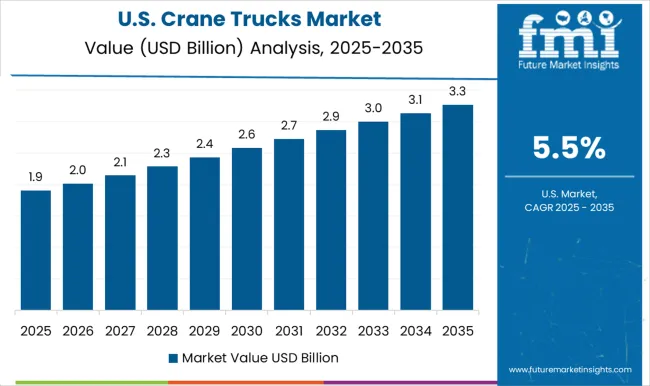
The USA crane truck market is expected to grow at a CAGR of 5.5% during 2025–2035, slightly below the global average of 6.5%. From 2020 to 2024, the market saw a CAGR of 4.3%, influenced by the recovery of the construction and industrial sectors following economic disruptions. The growth rate for 2025–2035 is expected to rise due to increased demand for crane trucks in infrastructure projects, including roadways, bridges, and renewable energy installations. The USA market is also benefiting from large-scale manufacturing projects in sectors like automotive, energy, and commercial real estate, where crane trucks are essential for heavy material handling. The continued push for zero-emission and energy-efficient machinery will also contribute to growth in the market, with manufacturers focusing on producing crane trucks with improved fuel efficiency and lower environmental impact. This shift towards more sustainable practices, along with a steady demand for crane trucks in urban and rural development, will drive the market's expansion.
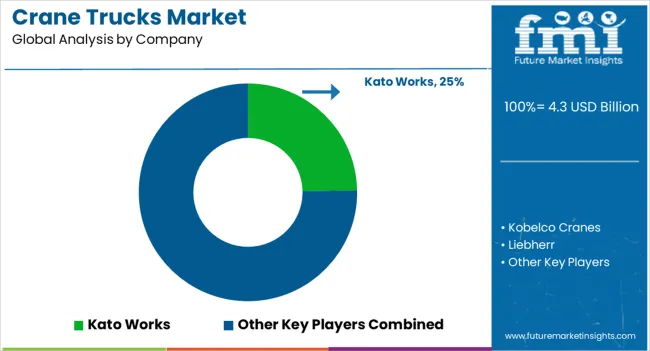
The crane trucks market is shaped by global leaders such as Kato Works, Kobelco Cranes, Liebherr, Manitowoc, Palfinger AG, Sany, Tadano, Terex, XCMG, and Zoomlion. These companies lead the market by offering a range of innovative lifting solutions for construction, logistics, and industrial applications. Kato Works is renowned for its highly reliable and compact mobile crane trucks that serve a wide range of industries, from construction to energy. Kobelco Cranes emphasizes technological advancement and heavy-lifting capacities, delivering specialized cranes for both urban and rugged environments. Liebherr’s strong reputation is built on its state-of-the-art hydraulic systems, offering versatile and robust cranes for diverse project needs. Manitowoc, with its Grove brand, is known for providing high-performance cranes, particularly in the mobile and crawler crane segments. Palfinger AG delivers high-tech crane solutions with a focus on versatility and energy efficiency, supporting construction and transportation sectors. Sany and Tadano also stand out for their affordable yet reliable crane trucks, catering to both domestic and international markets. Terex, XCMG, and Zoomlion focus on high-lifting capacities and innovative designs, positioning themselves as leaders in heavy-duty crane trucks that cater to large-scale infrastructure projects. Competitive strategies include expanding global footprints, enhancing lifting capabilities, and investing in smart, energy-efficient crane designs to meet evolving industry demands.
| Item | Value |
|---|---|
| Quantitative Units | USD 4.3 Billion |
| Offering | Lattice boom crane truck, Telescopic crane truck, and Knuckle boom crane truck |
| Lifting Capacity | Up to 20 tons, 21 to 50 tons, 51 to 100 tons, and Above 100 tons |
| Application | Construction, Utility, Mining, and Others |
| Regions Covered | North America, Europe, Asia-Pacific, Latin America, Middle East & Africa |
| Country Covered | United States, Canada, Germany, France, United Kingdom, China, Japan, India, Brazil, South Africa |
| Key Companies Profiled | Kato Works, Kobelco Cranes, Liebherr, Manitowoc, Palfinger AG, Sany, Tadano, Terex, XCMG, and Zoomlion |
| Additional Attributes | Dollar sales and market share by region, segment, and application, understanding the key drivers such as infrastructure development, ongoing construction projects, and industrial expansion is crucial. |
The global crane trucks market is estimated to be valued at USD 4.3 billion in 2025.
The market size for the crane trucks market is projected to reach USD 8.1 billion by 2035.
The crane trucks market is expected to grow at a 6.5% CAGR between 2025 and 2035.
The key product types in crane trucks market are lattice boom crane truck, telescopic crane truck and knuckle boom crane truck.
In terms of lifting capacity, up to 20 tons segment to command 38.9% share in the crane trucks market in 2025.






Our Research Products

The "Full Research Suite" delivers actionable market intel, deep dives on markets or technologies, so clients act faster, cut risk, and unlock growth.

The Leaderboard benchmarks and ranks top vendors, classifying them as Established Leaders, Leading Challengers, or Disruptors & Challengers.

Locates where complements amplify value and substitutes erode it, forecasting net impact by horizon

We deliver granular, decision-grade intel: market sizing, 5-year forecasts, pricing, adoption, usage, revenue, and operational KPIs—plus competitor tracking, regulation, and value chains—across 60 countries broadly.

Spot the shifts before they hit your P&L. We track inflection points, adoption curves, pricing moves, and ecosystem plays to show where demand is heading, why it is changing, and what to do next across high-growth markets and disruptive tech

Real-time reads of user behavior. We track shifting priorities, perceptions of today’s and next-gen services, and provider experience, then pace how fast tech moves from trial to adoption, blending buyer, consumer, and channel inputs with social signals (#WhySwitch, #UX).

Partner with our analyst team to build a custom report designed around your business priorities. From analysing market trends to assessing competitors or crafting bespoke datasets, we tailor insights to your needs.
Supplier Intelligence
Discovery & Profiling
Capacity & Footprint
Performance & Risk
Compliance & Governance
Commercial Readiness
Who Supplies Whom
Scorecards & Shortlists
Playbooks & Docs
Category Intelligence
Definition & Scope
Demand & Use Cases
Cost Drivers
Market Structure
Supply Chain Map
Trade & Policy
Operating Norms
Deliverables
Buyer Intelligence
Account Basics
Spend & Scope
Procurement Model
Vendor Requirements
Terms & Policies
Entry Strategy
Pain Points & Triggers
Outputs
Pricing Analysis
Benchmarks
Trends
Should-Cost
Indexation
Landed Cost
Commercial Terms
Deliverables
Brand Analysis
Positioning & Value Prop
Share & Presence
Customer Evidence
Go-to-Market
Digital & Reputation
Compliance & Trust
KPIs & Gaps
Outputs
Full Research Suite comprises of:
Market outlook & trends analysis
Interviews & case studies
Strategic recommendations
Vendor profiles & capabilities analysis
5-year forecasts
8 regions and 60+ country-level data splits
Market segment data splits
12 months of continuous data updates
DELIVERED AS:
PDF EXCEL ONLINE
Trucks Market Size and Share Forecast Outlook 2025 to 2035
Crane Cabin Market Analysis - Size, Share, and Forecast Outlook 2025 to 2035
Crane Rental Market Analysis by Product Type, End-Use Industry, and Region through 2035
Crane Aftermarket Growth – Trends & Forecast 2025 to 2035
Crane Motors Market Growth – Trends & Forecast 2025 to 2035
Crane Market Growth - Trends & Forecast 2025 to 2035
Key Companies & Market Share in Crane Scales Industry
Crane Scales Market Analysis – Growth, Demand & Forecast 2024-2034
Mini Cranes Market Size and Share Forecast Outlook 2025 to 2035
Yard Crane Market Size and Share Forecast Outlook 2025 to 2035
Hand Trucks And Dollies Market Size and Share Forecast Outlook 2025 to 2035
Dump Trucks Market Size and Share Forecast Outlook 2025 to 2035
Global Mini Cranes Market Share Analysis – Growth, Trends & Forecast 2025–2035
Fixed Cranes Market Size and Share Forecast Outlook 2025 to 2035
Tower Crane Rental Market Growth – Trends & Forecast 2025 to 2035
Tower Crane Market Growth - Trends & Forecast 2025 to 2035
Mobile Crane Market Size and Share Forecast Outlook 2025 to 2035
Mining Trucks Market Size and Share Forecast Outlook 2025 to 2035
Bucket Trucks Market Analysis - Size, Share, and Forecast Outlook 2025 to 2035
Marine Cranes Market Growth - Trends & Forecast 2025 to 2035

Thank you!
You will receive an email from our Business Development Manager. Please be sure to check your SPAM/JUNK folder too.
Chat With
MaRIA